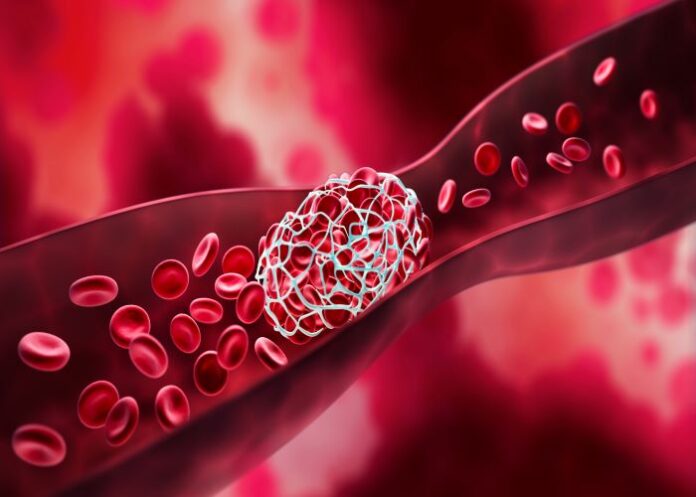The risk of developing a blood clot remains far higher than normal even a year after COVID-19 infection, recent research has revealed, with the risk of deep vein thrombosis being nearly double in people who’d had the virus compared with those who had not.
The study, led by the University of Bristol and published in academic journal Circulation, focused on health data of 48m people in the UK public health system, reports TimesLIVE. Of those, 1.4m had been diagnosed with COVID and of those, 10 500 had developed blood clot-related problems.
The American Heart Association, which publishes Circulation, said: “As seen in previous studies, COVID was linked to a sharply increased risk of blood clot-related issues, including heart attack and stroke, immediately after diagnosis compared with people who never had COVID.”
But the latest study found that risk remained higher for some problems “up to 49 weeks later”.
Jonathan Sterne, the study’s senior author, said the findings reinforce the message that for people who have cardiovascular conditions, “taking established preventive medications and managing your risk factors is even more important now than it was before the pandemic”.
A study of this nature has not been done in SA, but in the early days of the pandemic here, clinicians began to notice a dramatic rise in blood clots.
At the time, researchers said that understanding COVID as only a respiratory disease was incorrect, as it is also a cardiovascular one.
Professor Keertan Dheda, head of the Lung Institute at the University of Cape Town, said blood clots had not only been seen “clinically” during the pandemic (in the veins of the legs, abdomen, lungs and some arteries) but had also been “verified in post-mortem studies”, which had shown clots in the large blood vessels as well as in the small blood vessels of the skin and the lungs.
“This is a field of intensive research,” Dheda said, adding that COVID injures the cells that line blood vessels, causing a hyperinflammatory state made more dangerous by the patient lying immobile in a bed, thus leading excessive clots to form in the veins and sometimes arteries.
Study details
Association of COVID-19 With Major Arterial and Venous Thrombotic Diseases: A Population-Wide Cohort Study of 48 Million Adults in England and Wales
Rochelle Knight, Venexia Walker, Samantha Ip, Jennifer Cooper, Thomas Bolton, Spencer Keene, Rachel Denholm, Ashley Akbari, Hoda Abbasizanjani, Fatemeh Torabi, Efosa Omigie, Sam Hollings, Teri-Louise North, Renin Toms, Xiyun Jiang, Emanuele Di Angelantonio, Spiros Denaxas, Johan Thygesen, Christopher Tomlinson, Ben Bray, Craig Smith, Mark Barber, Kamlesh Khunti, George Davey Smith, Nishi Chaturvedi, Cathie Sudlow, William Whiteley, Angela Wood, Jonathan Sterne.
Published in Circulation on 19 September 2022
Abstract
Background
Infection with severe acute respiratory syndrome coronavirus 2 (SARS-CoV-2) induces a prothrombotic state, but long-term effects of COVID-19 on incidence of vascular diseases are unclear.
Methods
We studied vascular diseases after COVID-19 diagnosis in population-wide anonymised linked English and Welsh electronic health records from January 1 to December 7, 2020. We estimated adjusted hazard ratios comparing the incidence of arterial thromboses and venous thromboembolic events (VTEs) after diagnosis of COVID-19 with the incidence in people without a COVID-19 diagnosis. We conducted subgroup analyses by COVID-19 severity, demographic characteristics, and previous history.
Results
Among 48 million adults, 125 985 were hospitalised and 1 319 789 were not hospitalised within 28 days of COVID-19 diagnosis. In England, there were 260 279 first arterial thromboses and 59 421 first VTEs during 41.6 million person-years of follow-up. Adjusted hazard ratios for first arterial thrombosis after COVID-19 diagnosis compared with no COVID-19 diagnosis declined from 21.7 (95% CI, 21.0–22.4) in week 1 after COVID-19 diagnosis to 1.34 (95% CI, 1.21–1.48) during weeks 27 to 49. Adjusted hazard ratios for first VTE after COVID-19 diagnosis declined from 33.2 (95% CI, 31.3–35.2) in week 1 to 1.80 (95% CI, 1.50–2.17) during weeks 27 to 49. Adjusted hazard ratios were higher, for longer after diagnosis, after hospitalised versus nonhospitalised COVID-19, among Black or Asian versus White people, and among people without versus with a previous event. The estimated whole-population increases in risk of arterial thromboses and VTEs 49 weeks after COVID-19 diagnosis were 0.5% and 0.25%, respectively, corresponding to 7200 and 3500 additional events, respectively, after 1.4 million COVID-19 diagnoses.
Conclusions
High relative incidence of vascular events soon after COVID-19 diagnosis declines more rapidly for arterial thromboses than VTEs. However, incidence remains elevated up to 49 weeks after COVID-19 diagnosis. These results support policies to prevent severe COVID-19 by means of COVID-19 vaccines, early review after discharge, risk factor control, and use of secondary preventive agents in high-risk patients.
See more from MedicalBrief archives:
South African research sheds light on microclots’ role in long COVID
Scientists probe link between COVID symptoms, blood clots
Experimental drug to prevent COVID-19 blood clots — Imperial College trial
Microclot formation may have ‘long COVID’ implications – Stellenbosch

